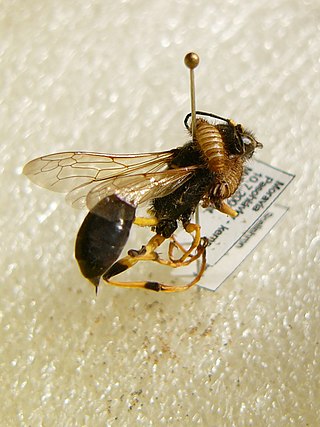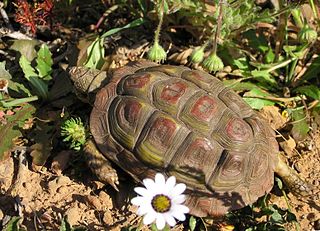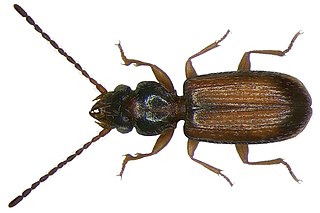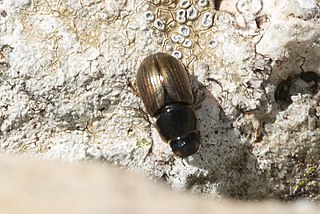
Beetles are insects that form the order Coleoptera, in the superorder Endopterygota. Their front pair of wings are hardened into wing-cases, elytra, distinguishing them from most other insects. The Coleoptera, with about 400,000 described species, is the largest of all orders, constituting almost 40% of described insects and 25% of all known animal species; new species are discovered frequently, with estimates suggesting that there are between 0.9 and 2.1 million total species. Found in almost every habitat except the sea and the polar regions, they interact with their ecosystems in several ways: beetles often feed on plants and fungi, break down animal and plant debris, and eat other invertebrates. Some species are serious agricultural pests, such as the Colorado potato beetle, while others such as Coccinellidae eat aphids, scale insects, thrips, and other plant-sucking insects that damage crops.

A pest is any animal or plant harmful to humans or human concerns. The term is particularly used for creatures that damage crops, livestock, and forestry or cause a nuisance to people, especially in their homes. Humans have modified the environment for their own purposes and are intolerant of other creatures occupying the same space when their activities impact adversely on human objectives. Thus, an elephant is unobjectionable in its natural habitat but a pest when it tramples crops.

The southern ground hornbill is one of two species of ground hornbill, both of which are found solely within Africa, and is the largest species in the hornbill order worldwide. It can be found in the southern regions of Africa, ranging from Kenya to South Africa. Within these regions, they inhabit both woodlands and savannas. The other species of the genus Bucorvus is the Abyssinian ground hornbill, B. abyssinicus.

The Asian long-horned beetle, also known as the starry sky, sky beetle, or ALB, is native to the Korean Peninsula, northern and southern China, and disputably in northern Japan. This species has now been accidentally introduced into the eastern United States, where it was first discovered in 1996, as well as Canada, and several countries in Europe, including Austria, France, Germany, Italy and UK.

Clearcutting, clearfelling or clearcut logging is a forestry/logging practice in which most or all trees in an area are uniformly cut down. Along with shelterwood and seed tree harvests, it is used by foresters to create certain types of forest ecosystems and to promote select species that require an abundance of sunlight or grow in large, even-age stands. Logging companies and forest-worker unions in some countries support the practice for scientific, safety and economic reasons, while detractors consider it a form of deforestation that destroys natural habitats and contributes to climate change.

In ecology, the term habitat summarises the array of resources, physical and biotic factors that are present in an area, such as to support the survival and reproduction of a particular species. A species habitat can be seen as the physical manifestation of its ecological niche. Thus "habitat" is a species-specific term, fundamentally different from concepts such as environment or vegetation assemblages, for which the term "habitat-type" is more appropriate.

The golden poison frog, also known as the golden dart frog or golden poison arrow frog, is a poison dart frog endemic to the rainforests of Colombia. The golden poison frog has become endangered due to habitat destruction within its naturally limited range. Despite its small size, this frog is likely the most poisonous animal on the planet.

The crawfish frog is a medium-sized species of frog native to the prairies and grasslands of the central United States. It gets its name because it inhabits the burrows of crayfish for most of the year. They have defined golden or black circles all over their body.

Cleridae are a family of beetles of the superfamily Cleroidea. They are commonly known as checkered beetles. The family Cleridae has a worldwide distribution, and a variety of habitats and feeding preferences.

A beaver dam or beaver impoundment is a dam built by beavers to create a pond which protects against predators such as coyotes, wolves and bears, and holds their food during winter. These structures modify the natural environment in such a way that the overall ecosystem builds upon the change, making beavers a keystone species and ecosystem engineers. They build prolifically at night, carrying mud and stones with their forepaws and timber between their teeth.

The smooth-sided toad or spotted toad, formerly known as Bufo guttatus, is a species of toad in the family Bufonidae. It is found in the Amazonian Bolivia, Brazil, Colombia, Ecuador, Peru, and Venezuela, as well as the Guianas. Specimens from southern Peru, Bolivia, and Brazil might represent Rhaebo ecuadorensis described in 2012.

Global biodiversity is the measure of biodiversity on planet Earth and is defined as the total variability of life forms. More than 99 percent of all species that ever lived on Earth are estimated to be extinct. Estimates on the number of Earth's current species range from 2 million to 1 trillion, of which about 1.74 million have been databased thus far and over 80 percent have not yet been described. More recently, in May 2016, scientists reported that 1 trillion species are estimated to be on Earth currently with only one-thousandth of one percent described. The total amount of DNA base pairs on Earth, as a possible approximation of global biodiversity, is estimated at 5.0 x 1037, and weighs 50 billion tonnes. In comparison, the total mass of the biosphere has been estimated to be as much as 4 TtC (trillion tons of carbon).

Climate change has adversely affected terrestrial and marine ecosystems, including tundras, mangroves, coral reefs, and caves. Increasing global temperature, more frequent occurrence of extreme weather, and rising sea level are examples of the most impactful effects of climate change. Possible consequences of these effects include species decline and extinction, change within ecosystems, increased prevalence of invasive species, forests converting from carbon sinks to carbon sources, ocean acidification, disruption of the water cycle, and increased occurrence of natural disasters.

Homopus areolatus, commonly known as the common padloper or parrot-beaked tortoise, is a tiny species of tortoise of the genus Homopus, indigenous to the southern part of South Africa.

Red Moor is a nature reserve and Site of Special Scientific Interest (SSSI), noted for its biological characteristics, near Lanlivery in mid Cornwall, England, UK.

Perileptus is a genus of beetles in the family Carabidae, containing the following species:

Bembidion testaceum is a small, fast-moving water beetle in the Trechinae subfamily that can be found in Austria, Benelux, Bulgaria, Czech Republic, France, Germany, Great Britain, Greece, Hungary, Liechtenstein, Poland, Romania, Slovakia, Spain, Switzerland, Ukraine, and all states of former Yugoslavia.
Bembidion nigropiceum is a small, fast-moving water beetle in the Trechinae subfamily.

Cicindela albissima, commonly called the Coral Pink Sand Dunes tiger beetle is a species of tiger beetle endemic to Coral Pink Sand Dunes State Park in southern Utah, United States. It was originally described by Rumpp in 1962 as the subspecies Cicindela limbata albissima, but mitochondrial DNA, along with the species' morphological and geographical distinctiveness, have shown that it is a separate species. C. albissima can be distinguished from other Cicindela species by its restricted range and lack of pigmentation on its elytra.

Melinopterus consputus is a species of scarab beetle in the family Scarabaeidae, found in the Palearctic. The species is considered endangered in Germany.



















